Mental Illness and Critical Social Work Theories: A Reflection
VerifiedAdded on 2022/12/23
|11
|2818
|50
Report
AI Summary
This report presents a comprehensive analysis of mental illness through critical social work theories, drawing on supernatural, somatogenic, and psychogenic perspectives, and historical treatments including trephination and the asylum era. It examines the evolution of mental health care, the impact of stigma and societal factors, and the role of community mental health centers. The report then explores progressive social work perspectives informed by critical and postmodern theories, emphasizing deconstruction and individual agency. A reflection section integrates psychodynamic theory, the AASW mental health curriculum, and the importance of critical frameworks in social work education. The author emphasizes the need for social workers to address oppression and inequalities within mental health practices, advocating for a critical approach in emergent mental health programs and highlighting the intrinsic connection between critical practice, social change, and social justice.
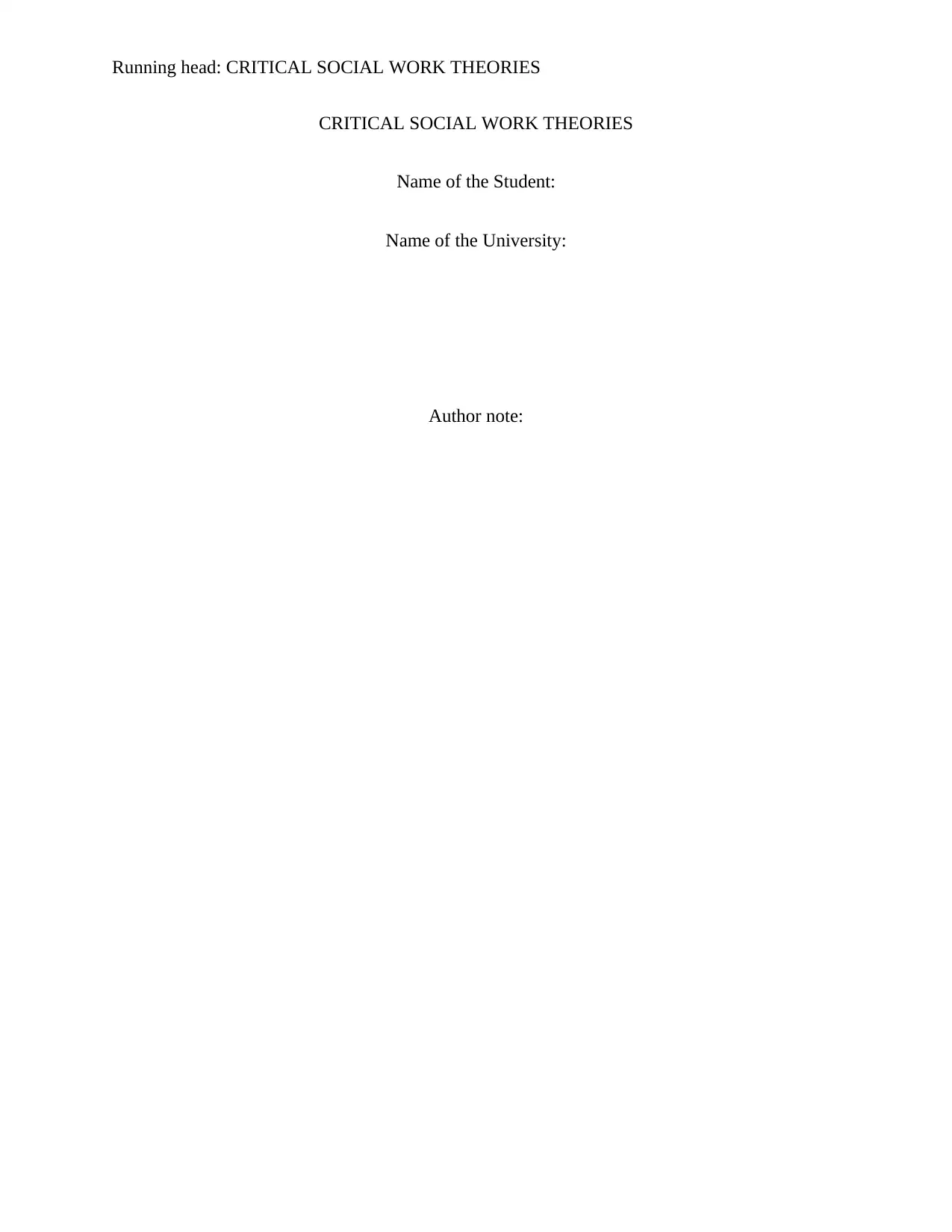
Running head: CRITICAL SOCIAL WORK THEORIES
CRITICAL SOCIAL WORK THEORIES
Name of the Student:
Name of the University:
Author note:
CRITICAL SOCIAL WORK THEORIES
Name of the Student:
Name of the University:
Author note:
Paraphrase This Document
Need a fresh take? Get an instant paraphrase of this document with our AI Paraphraser
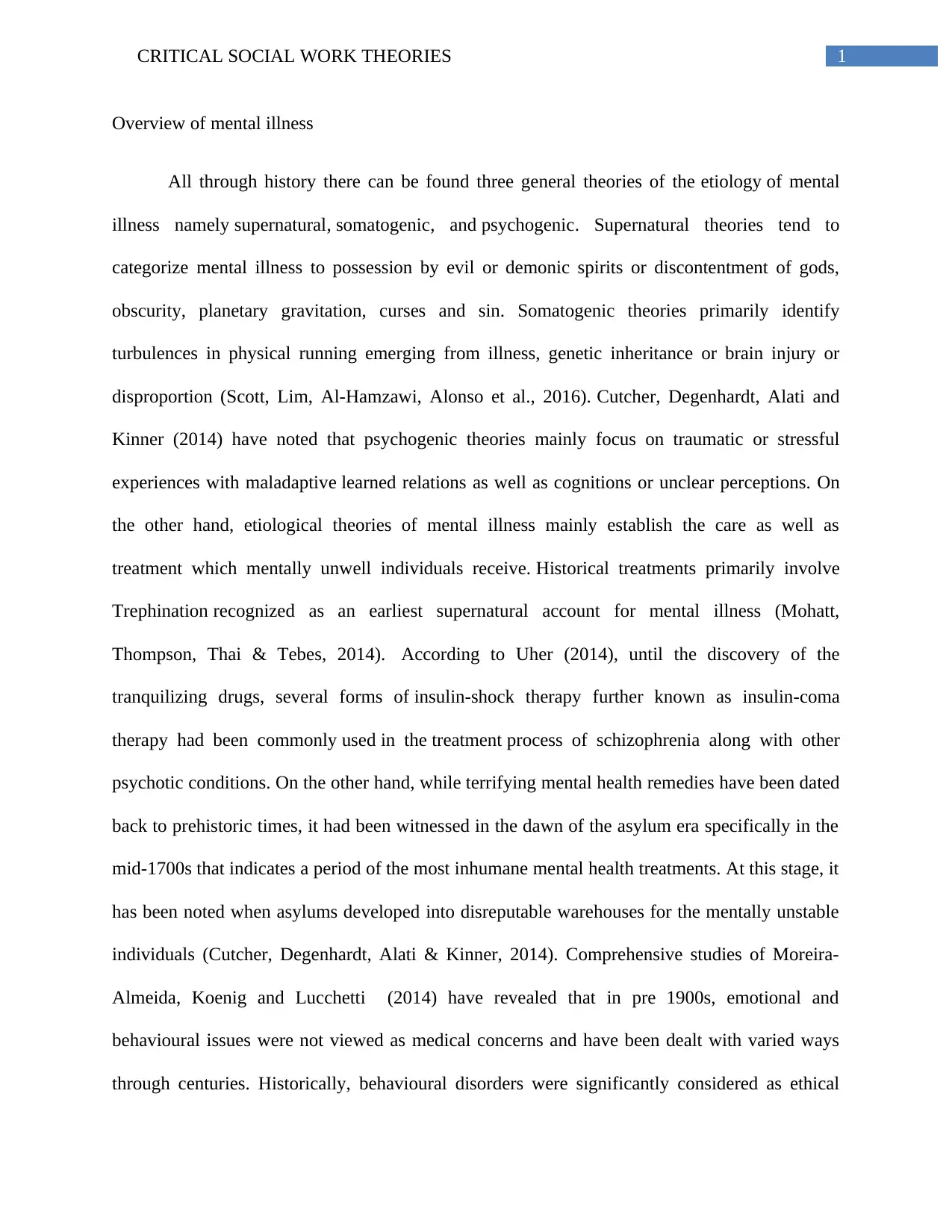
1CRITICAL SOCIAL WORK THEORIES
Overview of mental illness
All through history there can be found three general theories of the etiology of mental
illness namely supernatural, somatogenic, and psychogenic. Supernatural theories tend to
categorize mental illness to possession by evil or demonic spirits or discontentment of gods,
obscurity, planetary gravitation, curses and sin. Somatogenic theories primarily identify
turbulences in physical running emerging from illness, genetic inheritance or brain injury or
disproportion (Scott, Lim, Al-Hamzawi, Alonso et al., 2016). Cutcher, Degenhardt, Alati and
Kinner (2014) have noted that psychogenic theories mainly focus on traumatic or stressful
experiences with maladaptive learned relations as well as cognitions or unclear perceptions. On
the other hand, etiological theories of mental illness mainly establish the care as well as
treatment which mentally unwell individuals receive. Historical treatments primarily involve
Trephination recognized as an earliest supernatural account for mental illness (Mohatt,
Thompson, Thai & Tebes, 2014). According to Uher (2014), until the discovery of the
tranquilizing drugs, several forms of insulin-shock therapy further known as insulin-coma
therapy had been commonly used in the treatment process of schizophrenia along with other
psychotic conditions. On the other hand, while terrifying mental health remedies have been dated
back to prehistoric times, it had been witnessed in the dawn of the asylum era specifically in the
mid-1700s that indicates a period of the most inhumane mental health treatments. At this stage, it
has been noted when asylums developed into disreputable warehouses for the mentally unstable
individuals (Cutcher, Degenhardt, Alati & Kinner, 2014). Comprehensive studies of Moreira-
Almeida, Koenig and Lucchetti (2014) have revealed that in pre 1900s, emotional and
behavioural issues were not viewed as medical concerns and have been dealt with varied ways
through centuries. Historically, behavioural disorders were significantly considered as ethical
Overview of mental illness
All through history there can be found three general theories of the etiology of mental
illness namely supernatural, somatogenic, and psychogenic. Supernatural theories tend to
categorize mental illness to possession by evil or demonic spirits or discontentment of gods,
obscurity, planetary gravitation, curses and sin. Somatogenic theories primarily identify
turbulences in physical running emerging from illness, genetic inheritance or brain injury or
disproportion (Scott, Lim, Al-Hamzawi, Alonso et al., 2016). Cutcher, Degenhardt, Alati and
Kinner (2014) have noted that psychogenic theories mainly focus on traumatic or stressful
experiences with maladaptive learned relations as well as cognitions or unclear perceptions. On
the other hand, etiological theories of mental illness mainly establish the care as well as
treatment which mentally unwell individuals receive. Historical treatments primarily involve
Trephination recognized as an earliest supernatural account for mental illness (Mohatt,
Thompson, Thai & Tebes, 2014). According to Uher (2014), until the discovery of the
tranquilizing drugs, several forms of insulin-shock therapy further known as insulin-coma
therapy had been commonly used in the treatment process of schizophrenia along with other
psychotic conditions. On the other hand, while terrifying mental health remedies have been dated
back to prehistoric times, it had been witnessed in the dawn of the asylum era specifically in the
mid-1700s that indicates a period of the most inhumane mental health treatments. At this stage, it
has been noted when asylums developed into disreputable warehouses for the mentally unstable
individuals (Cutcher, Degenhardt, Alati & Kinner, 2014). Comprehensive studies of Moreira-
Almeida, Koenig and Lucchetti (2014) have revealed that in pre 1900s, emotional and
behavioural issues were not viewed as medical concerns and have been dealt with varied ways
through centuries. Historically, behavioural disorders were significantly considered as ethical
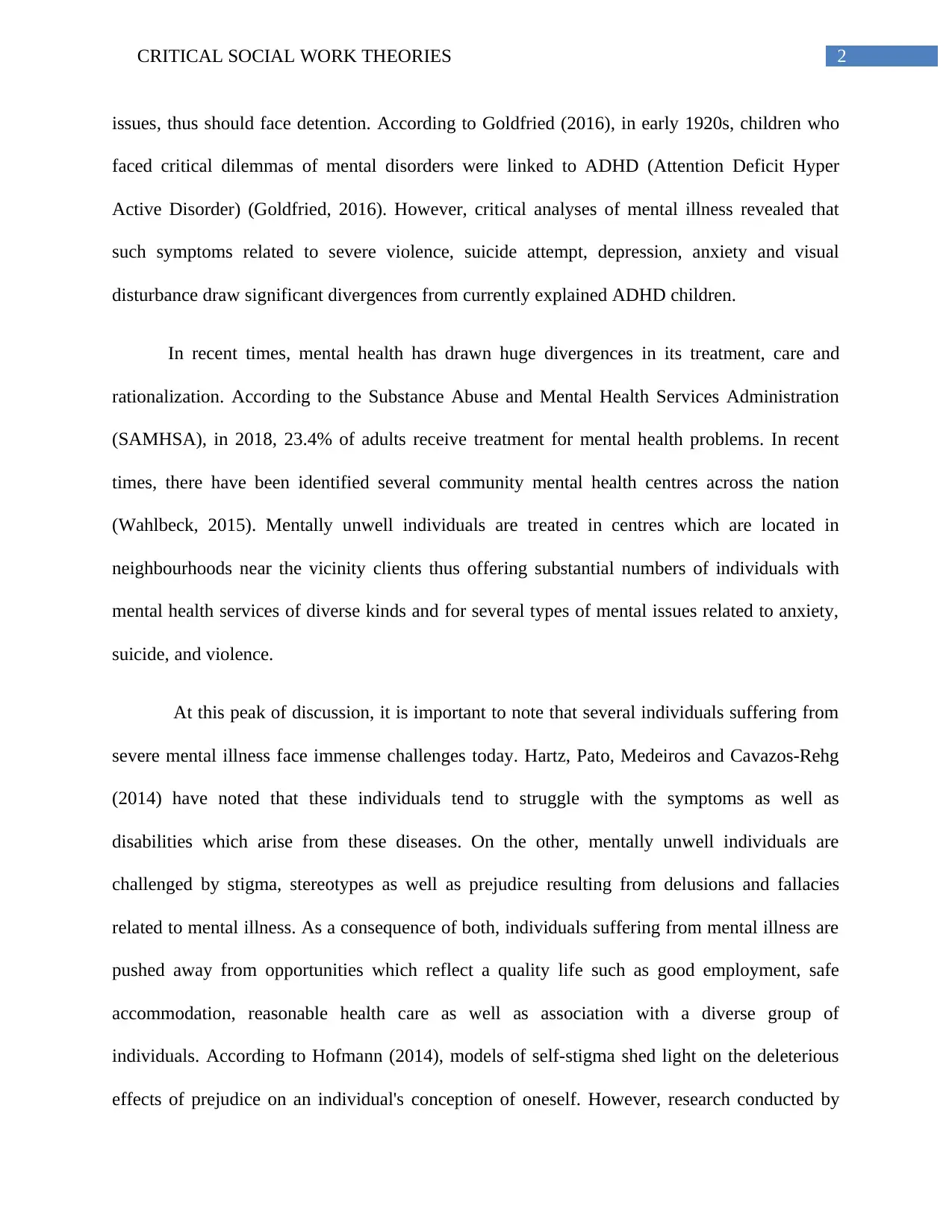
2CRITICAL SOCIAL WORK THEORIES
issues, thus should face detention. According to Goldfried (2016), in early 1920s, children who
faced critical dilemmas of mental disorders were linked to ADHD (Attention Deficit Hyper
Active Disorder) (Goldfried, 2016). However, critical analyses of mental illness revealed that
such symptoms related to severe violence, suicide attempt, depression, anxiety and visual
disturbance draw significant divergences from currently explained ADHD children.
In recent times, mental health has drawn huge divergences in its treatment, care and
rationalization. According to the Substance Abuse and Mental Health Services Administration
(SAMHSA), in 2018, 23.4% of adults receive treatment for mental health problems. In recent
times, there have been identified several community mental health centres across the nation
(Wahlbeck, 2015). Mentally unwell individuals are treated in centres which are located in
neighbourhoods near the vicinity clients thus offering substantial numbers of individuals with
mental health services of diverse kinds and for several types of mental issues related to anxiety,
suicide, and violence.
At this peak of discussion, it is important to note that several individuals suffering from
severe mental illness face immense challenges today. Hartz, Pato, Medeiros and Cavazos-Rehg
(2014) have noted that these individuals tend to struggle with the symptoms as well as
disabilities which arise from these diseases. On the other, mentally unwell individuals are
challenged by stigma, stereotypes as well as prejudice resulting from delusions and fallacies
related to mental illness. As a consequence of both, individuals suffering from mental illness are
pushed away from opportunities which reflect a quality life such as good employment, safe
accommodation, reasonable health care as well as association with a diverse group of
individuals. According to Hofmann (2014), models of self-stigma shed light on the deleterious
effects of prejudice on an individual's conception of oneself. However, research conducted by
issues, thus should face detention. According to Goldfried (2016), in early 1920s, children who
faced critical dilemmas of mental disorders were linked to ADHD (Attention Deficit Hyper
Active Disorder) (Goldfried, 2016). However, critical analyses of mental illness revealed that
such symptoms related to severe violence, suicide attempt, depression, anxiety and visual
disturbance draw significant divergences from currently explained ADHD children.
In recent times, mental health has drawn huge divergences in its treatment, care and
rationalization. According to the Substance Abuse and Mental Health Services Administration
(SAMHSA), in 2018, 23.4% of adults receive treatment for mental health problems. In recent
times, there have been identified several community mental health centres across the nation
(Wahlbeck, 2015). Mentally unwell individuals are treated in centres which are located in
neighbourhoods near the vicinity clients thus offering substantial numbers of individuals with
mental health services of diverse kinds and for several types of mental issues related to anxiety,
suicide, and violence.
At this peak of discussion, it is important to note that several individuals suffering from
severe mental illness face immense challenges today. Hartz, Pato, Medeiros and Cavazos-Rehg
(2014) have noted that these individuals tend to struggle with the symptoms as well as
disabilities which arise from these diseases. On the other, mentally unwell individuals are
challenged by stigma, stereotypes as well as prejudice resulting from delusions and fallacies
related to mental illness. As a consequence of both, individuals suffering from mental illness are
pushed away from opportunities which reflect a quality life such as good employment, safe
accommodation, reasonable health care as well as association with a diverse group of
individuals. According to Hofmann (2014), models of self-stigma shed light on the deleterious
effects of prejudice on an individual's conception of oneself. However, research conducted by
⊘ This is a preview!⊘
Do you want full access?
Subscribe today to unlock all pages.

Trusted by 1+ million students worldwide
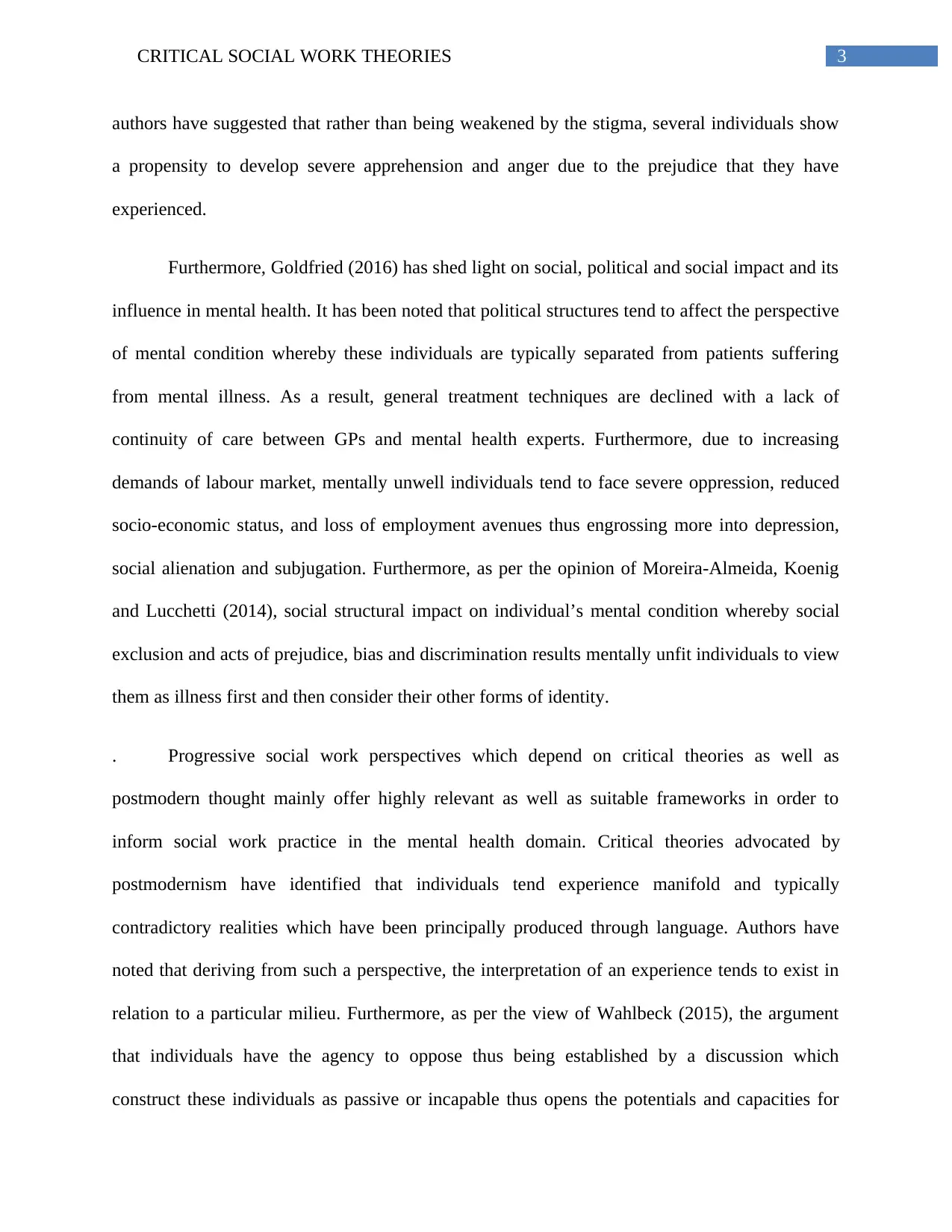
3CRITICAL SOCIAL WORK THEORIES
authors have suggested that rather than being weakened by the stigma, several individuals show
a propensity to develop severe apprehension and anger due to the prejudice that they have
experienced.
Furthermore, Goldfried (2016) has shed light on social, political and social impact and its
influence in mental health. It has been noted that political structures tend to affect the perspective
of mental condition whereby these individuals are typically separated from patients suffering
from mental illness. As a result, general treatment techniques are declined with a lack of
continuity of care between GPs and mental health experts. Furthermore, due to increasing
demands of labour market, mentally unwell individuals tend to face severe oppression, reduced
socio-economic status, and loss of employment avenues thus engrossing more into depression,
social alienation and subjugation. Furthermore, as per the opinion of Moreira-Almeida, Koenig
and Lucchetti (2014), social structural impact on individual’s mental condition whereby social
exclusion and acts of prejudice, bias and discrimination results mentally unfit individuals to view
them as illness first and then consider their other forms of identity.
. Progressive social work perspectives which depend on critical theories as well as
postmodern thought mainly offer highly relevant as well as suitable frameworks in order to
inform social work practice in the mental health domain. Critical theories advocated by
postmodernism have identified that individuals tend experience manifold and typically
contradictory realities which have been principally produced through language. Authors have
noted that deriving from such a perspective, the interpretation of an experience tends to exist in
relation to a particular milieu. Furthermore, as per the view of Wahlbeck (2015), the argument
that individuals have the agency to oppose thus being established by a discussion which
construct these individuals as passive or incapable thus opens the potentials and capacities for
authors have suggested that rather than being weakened by the stigma, several individuals show
a propensity to develop severe apprehension and anger due to the prejudice that they have
experienced.
Furthermore, Goldfried (2016) has shed light on social, political and social impact and its
influence in mental health. It has been noted that political structures tend to affect the perspective
of mental condition whereby these individuals are typically separated from patients suffering
from mental illness. As a result, general treatment techniques are declined with a lack of
continuity of care between GPs and mental health experts. Furthermore, due to increasing
demands of labour market, mentally unwell individuals tend to face severe oppression, reduced
socio-economic status, and loss of employment avenues thus engrossing more into depression,
social alienation and subjugation. Furthermore, as per the opinion of Moreira-Almeida, Koenig
and Lucchetti (2014), social structural impact on individual’s mental condition whereby social
exclusion and acts of prejudice, bias and discrimination results mentally unfit individuals to view
them as illness first and then consider their other forms of identity.
. Progressive social work perspectives which depend on critical theories as well as
postmodern thought mainly offer highly relevant as well as suitable frameworks in order to
inform social work practice in the mental health domain. Critical theories advocated by
postmodernism have identified that individuals tend experience manifold and typically
contradictory realities which have been principally produced through language. Authors have
noted that deriving from such a perspective, the interpretation of an experience tends to exist in
relation to a particular milieu. Furthermore, as per the view of Wahlbeck (2015), the argument
that individuals have the agency to oppose thus being established by a discussion which
construct these individuals as passive or incapable thus opens the potentials and capacities for
Paraphrase This Document
Need a fresh take? Get an instant paraphrase of this document with our AI Paraphraser
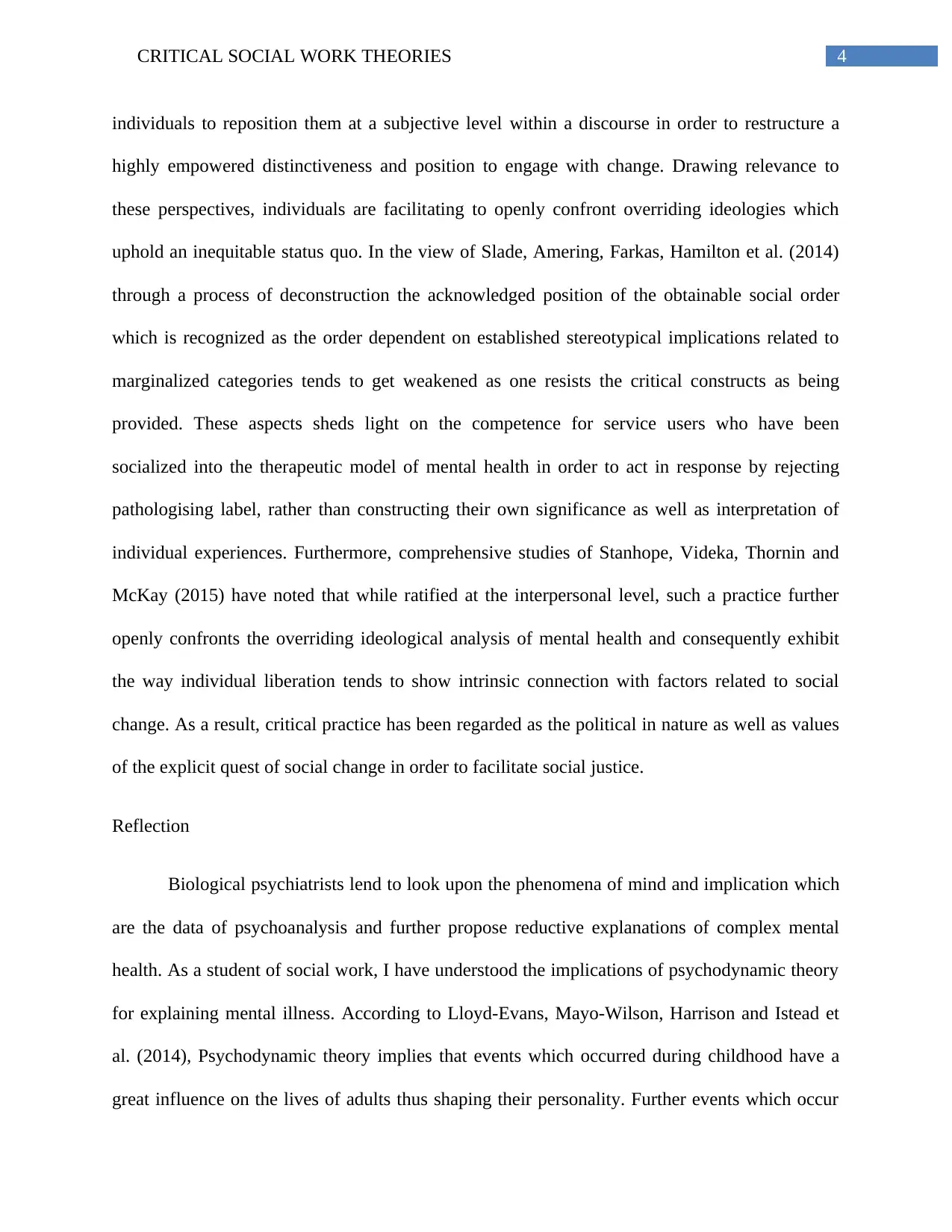
4CRITICAL SOCIAL WORK THEORIES
individuals to reposition them at a subjective level within a discourse in order to restructure a
highly empowered distinctiveness and position to engage with change. Drawing relevance to
these perspectives, individuals are facilitating to openly confront overriding ideologies which
uphold an inequitable status quo. In the view of Slade, Amering, Farkas, Hamilton et al. (2014)
through a process of deconstruction the acknowledged position of the obtainable social order
which is recognized as the order dependent on established stereotypical implications related to
marginalized categories tends to get weakened as one resists the critical constructs as being
provided. These aspects sheds light on the competence for service users who have been
socialized into the therapeutic model of mental health in order to act in response by rejecting
pathologising label, rather than constructing their own significance as well as interpretation of
individual experiences. Furthermore, comprehensive studies of Stanhope, Videka, Thornin and
McKay (2015) have noted that while ratified at the interpersonal level, such a practice further
openly confronts the overriding ideological analysis of mental health and consequently exhibit
the way individual liberation tends to show intrinsic connection with factors related to social
change. As a result, critical practice has been regarded as the political in nature as well as values
of the explicit quest of social change in order to facilitate social justice.
Reflection
Biological psychiatrists lend to look upon the phenomena of mind and implication which
are the data of psychoanalysis and further propose reductive explanations of complex mental
health. As a student of social work, I have understood the implications of psychodynamic theory
for explaining mental illness. According to Lloyd-Evans, Mayo-Wilson, Harrison and Istead et
al. (2014), Psychodynamic theory implies that events which occurred during childhood have a
great influence on the lives of adults thus shaping their personality. Further events which occur
individuals to reposition them at a subjective level within a discourse in order to restructure a
highly empowered distinctiveness and position to engage with change. Drawing relevance to
these perspectives, individuals are facilitating to openly confront overriding ideologies which
uphold an inequitable status quo. In the view of Slade, Amering, Farkas, Hamilton et al. (2014)
through a process of deconstruction the acknowledged position of the obtainable social order
which is recognized as the order dependent on established stereotypical implications related to
marginalized categories tends to get weakened as one resists the critical constructs as being
provided. These aspects sheds light on the competence for service users who have been
socialized into the therapeutic model of mental health in order to act in response by rejecting
pathologising label, rather than constructing their own significance as well as interpretation of
individual experiences. Furthermore, comprehensive studies of Stanhope, Videka, Thornin and
McKay (2015) have noted that while ratified at the interpersonal level, such a practice further
openly confronts the overriding ideological analysis of mental health and consequently exhibit
the way individual liberation tends to show intrinsic connection with factors related to social
change. As a result, critical practice has been regarded as the political in nature as well as values
of the explicit quest of social change in order to facilitate social justice.
Reflection
Biological psychiatrists lend to look upon the phenomena of mind and implication which
are the data of psychoanalysis and further propose reductive explanations of complex mental
health. As a student of social work, I have understood the implications of psychodynamic theory
for explaining mental illness. According to Lloyd-Evans, Mayo-Wilson, Harrison and Istead et
al. (2014), Psychodynamic theory implies that events which occurred during childhood have a
great influence on the lives of adults thus shaping their personality. Further events which occur
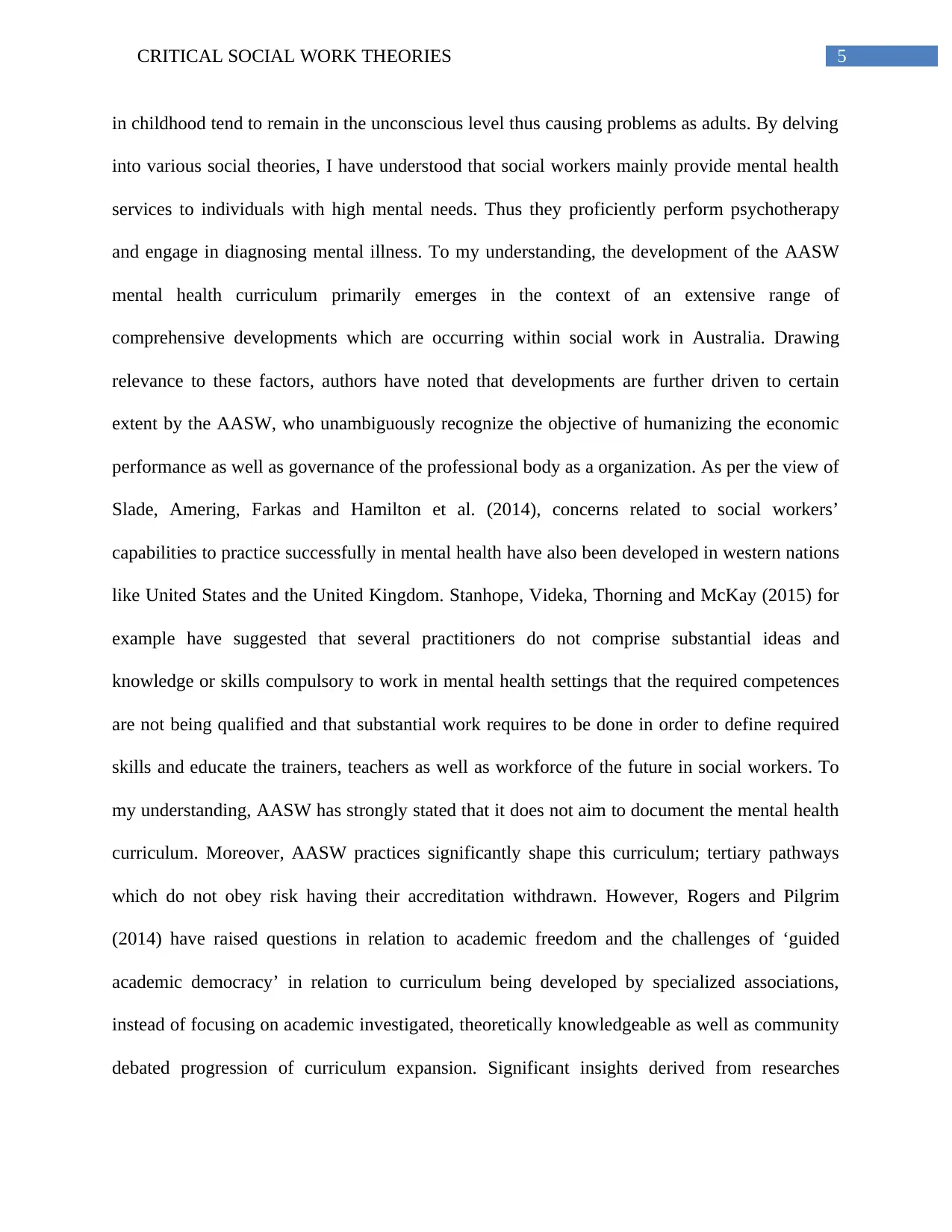
5CRITICAL SOCIAL WORK THEORIES
in childhood tend to remain in the unconscious level thus causing problems as adults. By delving
into various social theories, I have understood that social workers mainly provide mental health
services to individuals with high mental needs. Thus they proficiently perform psychotherapy
and engage in diagnosing mental illness. To my understanding, the development of the AASW
mental health curriculum primarily emerges in the context of an extensive range of
comprehensive developments which are occurring within social work in Australia. Drawing
relevance to these factors, authors have noted that developments are further driven to certain
extent by the AASW, who unambiguously recognize the objective of humanizing the economic
performance as well as governance of the professional body as a organization. As per the view of
Slade, Amering, Farkas and Hamilton et al. (2014), concerns related to social workers’
capabilities to practice successfully in mental health have also been developed in western nations
like United States and the United Kingdom. Stanhope, Videka, Thorning and McKay (2015) for
example have suggested that several practitioners do not comprise substantial ideas and
knowledge or skills compulsory to work in mental health settings that the required competences
are not being qualified and that substantial work requires to be done in order to define required
skills and educate the trainers, teachers as well as workforce of the future in social workers. To
my understanding, AASW has strongly stated that it does not aim to document the mental health
curriculum. Moreover, AASW practices significantly shape this curriculum; tertiary pathways
which do not obey risk having their accreditation withdrawn. However, Rogers and Pilgrim
(2014) have raised questions in relation to academic freedom and the challenges of ‘guided
academic democracy’ in relation to curriculum being developed by specialized associations,
instead of focusing on academic investigated, theoretically knowledgeable as well as community
debated progression of curriculum expansion. Significant insights derived from researches
in childhood tend to remain in the unconscious level thus causing problems as adults. By delving
into various social theories, I have understood that social workers mainly provide mental health
services to individuals with high mental needs. Thus they proficiently perform psychotherapy
and engage in diagnosing mental illness. To my understanding, the development of the AASW
mental health curriculum primarily emerges in the context of an extensive range of
comprehensive developments which are occurring within social work in Australia. Drawing
relevance to these factors, authors have noted that developments are further driven to certain
extent by the AASW, who unambiguously recognize the objective of humanizing the economic
performance as well as governance of the professional body as a organization. As per the view of
Slade, Amering, Farkas and Hamilton et al. (2014), concerns related to social workers’
capabilities to practice successfully in mental health have also been developed in western nations
like United States and the United Kingdom. Stanhope, Videka, Thorning and McKay (2015) for
example have suggested that several practitioners do not comprise substantial ideas and
knowledge or skills compulsory to work in mental health settings that the required competences
are not being qualified and that substantial work requires to be done in order to define required
skills and educate the trainers, teachers as well as workforce of the future in social workers. To
my understanding, AASW has strongly stated that it does not aim to document the mental health
curriculum. Moreover, AASW practices significantly shape this curriculum; tertiary pathways
which do not obey risk having their accreditation withdrawn. However, Rogers and Pilgrim
(2014) have raised questions in relation to academic freedom and the challenges of ‘guided
academic democracy’ in relation to curriculum being developed by specialized associations,
instead of focusing on academic investigated, theoretically knowledgeable as well as community
debated progression of curriculum expansion. Significant insights derived from researches
⊘ This is a preview!⊘
Do you want full access?
Subscribe today to unlock all pages.

Trusted by 1+ million students worldwide
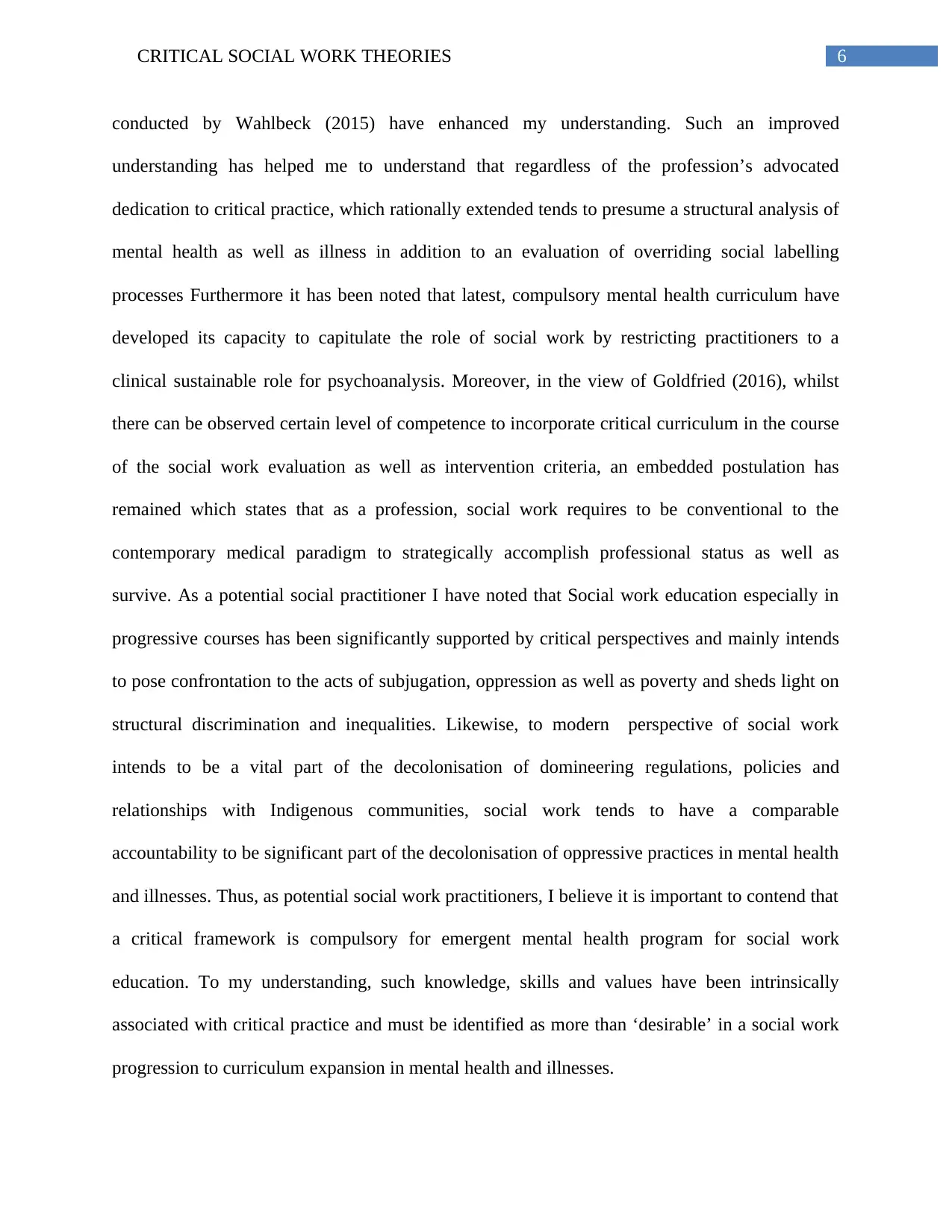
6CRITICAL SOCIAL WORK THEORIES
conducted by Wahlbeck (2015) have enhanced my understanding. Such an improved
understanding has helped me to understand that regardless of the profession’s advocated
dedication to critical practice, which rationally extended tends to presume a structural analysis of
mental health as well as illness in addition to an evaluation of overriding social labelling
processes Furthermore it has been noted that latest, compulsory mental health curriculum have
developed its capacity to capitulate the role of social work by restricting practitioners to a
clinical sustainable role for psychoanalysis. Moreover, in the view of Goldfried (2016), whilst
there can be observed certain level of competence to incorporate critical curriculum in the course
of the social work evaluation as well as intervention criteria, an embedded postulation has
remained which states that as a profession, social work requires to be conventional to the
contemporary medical paradigm to strategically accomplish professional status as well as
survive. As a potential social practitioner I have noted that Social work education especially in
progressive courses has been significantly supported by critical perspectives and mainly intends
to pose confrontation to the acts of subjugation, oppression as well as poverty and sheds light on
structural discrimination and inequalities. Likewise, to modern perspective of social work
intends to be a vital part of the decolonisation of domineering regulations, policies and
relationships with Indigenous communities, social work tends to have a comparable
accountability to be significant part of the decolonisation of oppressive practices in mental health
and illnesses. Thus, as potential social work practitioners, I believe it is important to contend that
a critical framework is compulsory for emergent mental health program for social work
education. To my understanding, such knowledge, skills and values have been intrinsically
associated with critical practice and must be identified as more than ‘desirable’ in a social work
progression to curriculum expansion in mental health and illnesses.
conducted by Wahlbeck (2015) have enhanced my understanding. Such an improved
understanding has helped me to understand that regardless of the profession’s advocated
dedication to critical practice, which rationally extended tends to presume a structural analysis of
mental health as well as illness in addition to an evaluation of overriding social labelling
processes Furthermore it has been noted that latest, compulsory mental health curriculum have
developed its capacity to capitulate the role of social work by restricting practitioners to a
clinical sustainable role for psychoanalysis. Moreover, in the view of Goldfried (2016), whilst
there can be observed certain level of competence to incorporate critical curriculum in the course
of the social work evaluation as well as intervention criteria, an embedded postulation has
remained which states that as a profession, social work requires to be conventional to the
contemporary medical paradigm to strategically accomplish professional status as well as
survive. As a potential social practitioner I have noted that Social work education especially in
progressive courses has been significantly supported by critical perspectives and mainly intends
to pose confrontation to the acts of subjugation, oppression as well as poverty and sheds light on
structural discrimination and inequalities. Likewise, to modern perspective of social work
intends to be a vital part of the decolonisation of domineering regulations, policies and
relationships with Indigenous communities, social work tends to have a comparable
accountability to be significant part of the decolonisation of oppressive practices in mental health
and illnesses. Thus, as potential social work practitioners, I believe it is important to contend that
a critical framework is compulsory for emergent mental health program for social work
education. To my understanding, such knowledge, skills and values have been intrinsically
associated with critical practice and must be identified as more than ‘desirable’ in a social work
progression to curriculum expansion in mental health and illnesses.
Paraphrase This Document
Need a fresh take? Get an instant paraphrase of this document with our AI Paraphraser

7CRITICAL SOCIAL WORK THEORIES
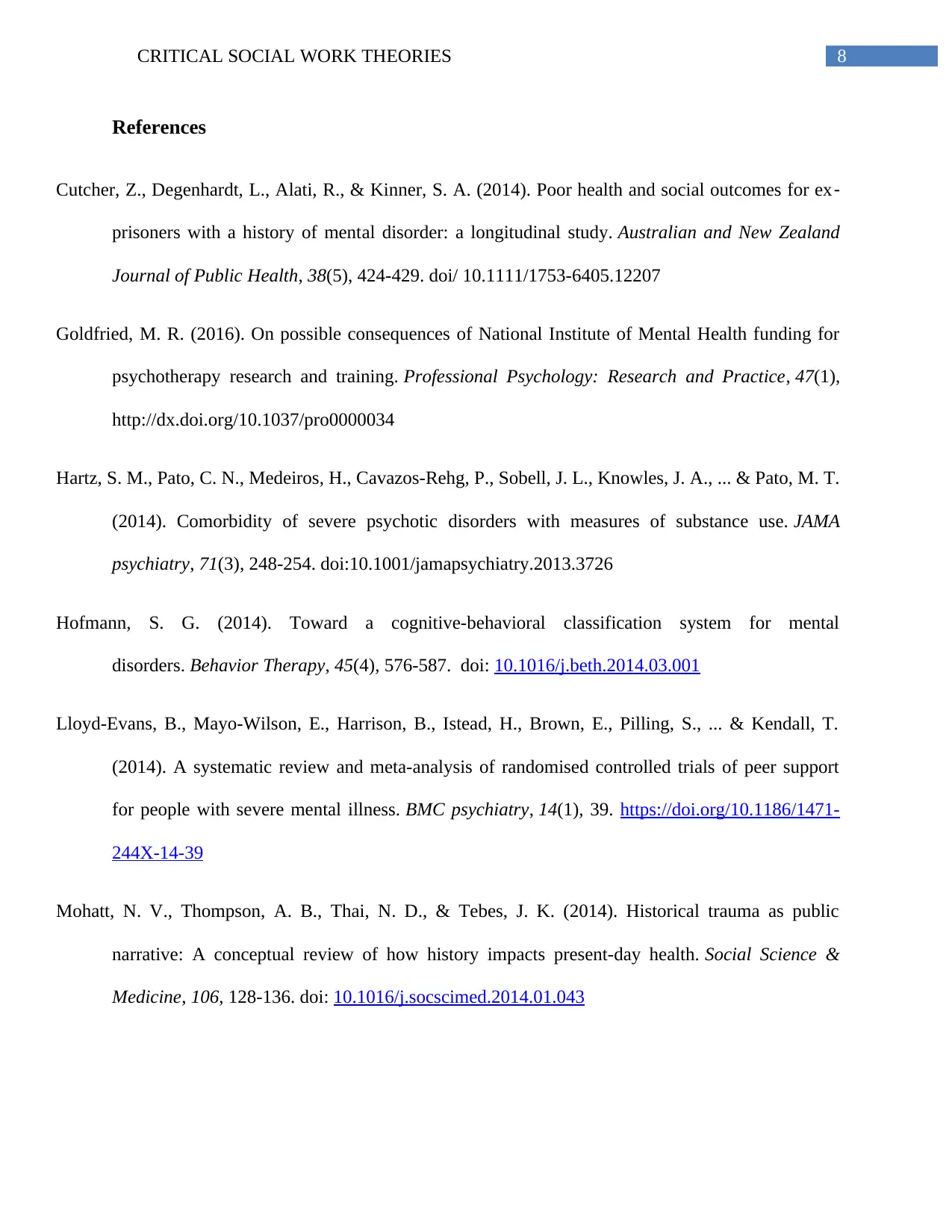
8CRITICAL SOCIAL WORK THEORIES
References
Cutcher, Z., Degenhardt, L., Alati, R., & Kinner, S. A. (2014). Poor health and social outcomes for ex‐
prisoners with a history of mental disorder: a longitudinal study. Australian and New Zealand
Journal of Public Health, 38(5), 424-429. doi/ 10.1111/1753-6405.12207
Goldfried, M. R. (2016). On possible consequences of National Institute of Mental Health funding for
psychotherapy research and training. Professional Psychology: Research and Practice, 47(1),
http://dx.doi.org/10.1037/pro0000034
Hartz, S. M., Pato, C. N., Medeiros, H., Cavazos-Rehg, P., Sobell, J. L., Knowles, J. A., ... & Pato, M. T.
(2014). Comorbidity of severe psychotic disorders with measures of substance use. JAMA
psychiatry, 71(3), 248-254. doi:10.1001/jamapsychiatry.2013.3726
Hofmann, S. G. (2014). Toward a cognitive-behavioral classification system for mental
disorders. Behavior Therapy, 45(4), 576-587. doi: 10.1016/j.beth.2014.03.001
Lloyd-Evans, B., Mayo-Wilson, E., Harrison, B., Istead, H., Brown, E., Pilling, S., ... & Kendall, T.
(2014). A systematic review and meta-analysis of randomised controlled trials of peer support
for people with severe mental illness. BMC psychiatry, 14(1), 39. https://doi.org/10.1186/1471-
244X-14-39
Mohatt, N. V., Thompson, A. B., Thai, N. D., & Tebes, J. K. (2014). Historical trauma as public
narrative: A conceptual review of how history impacts present-day health. Social Science &
Medicine, 106, 128-136. doi: 10.1016/j.socscimed.2014.01.043
References
Cutcher, Z., Degenhardt, L., Alati, R., & Kinner, S. A. (2014). Poor health and social outcomes for ex‐
prisoners with a history of mental disorder: a longitudinal study. Australian and New Zealand
Journal of Public Health, 38(5), 424-429. doi/ 10.1111/1753-6405.12207
Goldfried, M. R. (2016). On possible consequences of National Institute of Mental Health funding for
psychotherapy research and training. Professional Psychology: Research and Practice, 47(1),
http://dx.doi.org/10.1037/pro0000034
Hartz, S. M., Pato, C. N., Medeiros, H., Cavazos-Rehg, P., Sobell, J. L., Knowles, J. A., ... & Pato, M. T.
(2014). Comorbidity of severe psychotic disorders with measures of substance use. JAMA
psychiatry, 71(3), 248-254. doi:10.1001/jamapsychiatry.2013.3726
Hofmann, S. G. (2014). Toward a cognitive-behavioral classification system for mental
disorders. Behavior Therapy, 45(4), 576-587. doi: 10.1016/j.beth.2014.03.001
Lloyd-Evans, B., Mayo-Wilson, E., Harrison, B., Istead, H., Brown, E., Pilling, S., ... & Kendall, T.
(2014). A systematic review and meta-analysis of randomised controlled trials of peer support
for people with severe mental illness. BMC psychiatry, 14(1), 39. https://doi.org/10.1186/1471-
244X-14-39
Mohatt, N. V., Thompson, A. B., Thai, N. D., & Tebes, J. K. (2014). Historical trauma as public
narrative: A conceptual review of how history impacts present-day health. Social Science &
Medicine, 106, 128-136. doi: 10.1016/j.socscimed.2014.01.043
⊘ This is a preview!⊘
Do you want full access?
Subscribe today to unlock all pages.

Trusted by 1+ million students worldwide
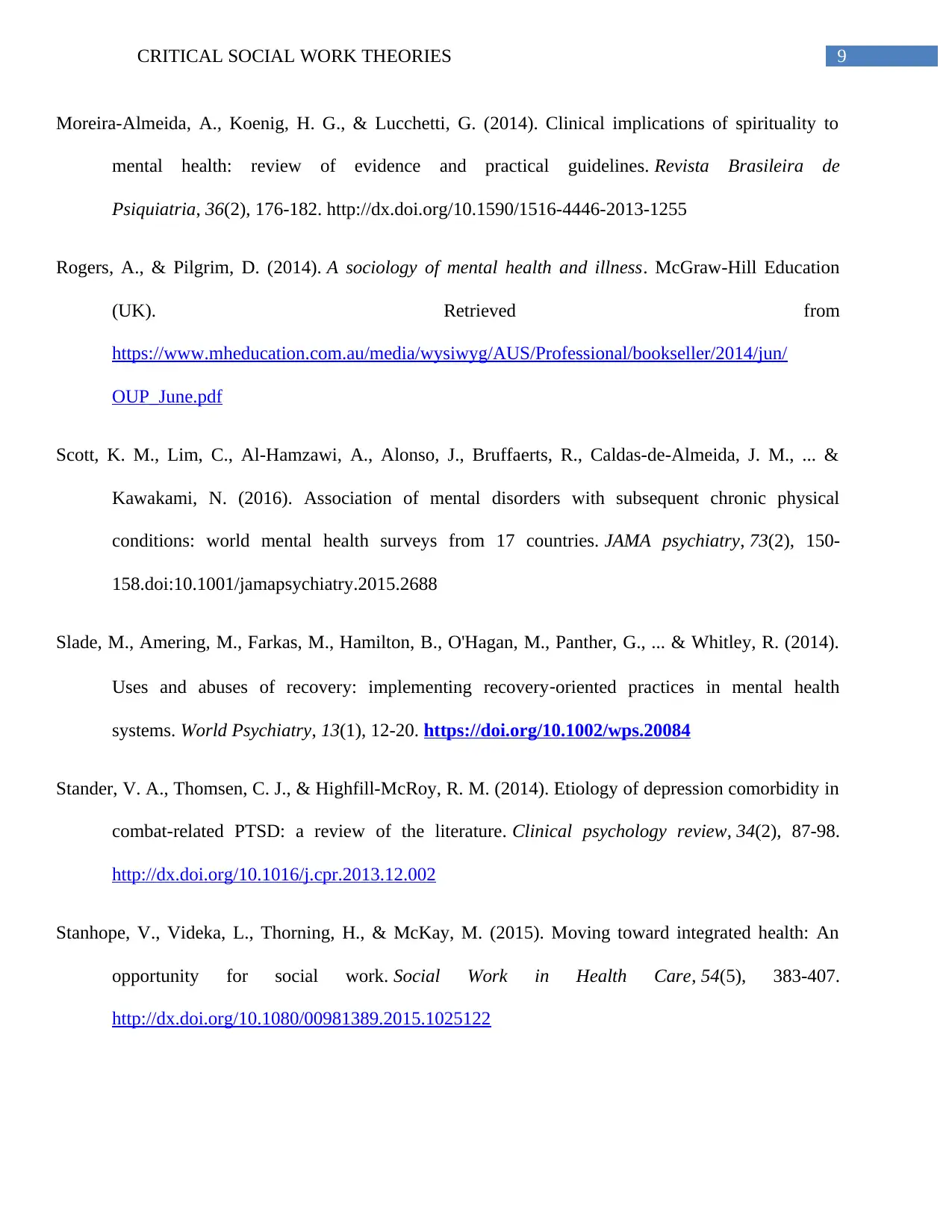
9CRITICAL SOCIAL WORK THEORIES
Moreira-Almeida, A., Koenig, H. G., & Lucchetti, G. (2014). Clinical implications of spirituality to
mental health: review of evidence and practical guidelines. Revista Brasileira de
Psiquiatria, 36(2), 176-182. http://dx.doi.org/10.1590/1516-4446-2013-1255
Rogers, A., & Pilgrim, D. (2014). A sociology of mental health and illness. McGraw-Hill Education
(UK). Retrieved from
https://www.mheducation.com.au/media/wysiwyg/AUS/Professional/bookseller/2014/jun/
OUP_June.pdf
Scott, K. M., Lim, C., Al-Hamzawi, A., Alonso, J., Bruffaerts, R., Caldas-de-Almeida, J. M., ... &
Kawakami, N. (2016). Association of mental disorders with subsequent chronic physical
conditions: world mental health surveys from 17 countries. JAMA psychiatry, 73(2), 150-
158.doi:10.1001/jamapsychiatry.2015.2688
Slade, M., Amering, M., Farkas, M., Hamilton, B., O'Hagan, M., Panther, G., ... & Whitley, R. (2014).
Uses and abuses of recovery: implementing recovery‐oriented practices in mental health
systems. World Psychiatry, 13(1), 12-20. https://doi.org/10.1002/wps.20084
Stander, V. A., Thomsen, C. J., & Highfill-McRoy, R. M. (2014). Etiology of depression comorbidity in
combat-related PTSD: a review of the literature. Clinical psychology review, 34(2), 87-98.
http://dx.doi.org/10.1016/j.cpr.2013.12.002
Stanhope, V., Videka, L., Thorning, H., & McKay, M. (2015). Moving toward integrated health: An
opportunity for social work. Social Work in Health Care, 54(5), 383-407.
http://dx.doi.org/10.1080/00981389.2015.1025122
Moreira-Almeida, A., Koenig, H. G., & Lucchetti, G. (2014). Clinical implications of spirituality to
mental health: review of evidence and practical guidelines. Revista Brasileira de
Psiquiatria, 36(2), 176-182. http://dx.doi.org/10.1590/1516-4446-2013-1255
Rogers, A., & Pilgrim, D. (2014). A sociology of mental health and illness. McGraw-Hill Education
(UK). Retrieved from
https://www.mheducation.com.au/media/wysiwyg/AUS/Professional/bookseller/2014/jun/
OUP_June.pdf
Scott, K. M., Lim, C., Al-Hamzawi, A., Alonso, J., Bruffaerts, R., Caldas-de-Almeida, J. M., ... &
Kawakami, N. (2016). Association of mental disorders with subsequent chronic physical
conditions: world mental health surveys from 17 countries. JAMA psychiatry, 73(2), 150-
158.doi:10.1001/jamapsychiatry.2015.2688
Slade, M., Amering, M., Farkas, M., Hamilton, B., O'Hagan, M., Panther, G., ... & Whitley, R. (2014).
Uses and abuses of recovery: implementing recovery‐oriented practices in mental health
systems. World Psychiatry, 13(1), 12-20. https://doi.org/10.1002/wps.20084
Stander, V. A., Thomsen, C. J., & Highfill-McRoy, R. M. (2014). Etiology of depression comorbidity in
combat-related PTSD: a review of the literature. Clinical psychology review, 34(2), 87-98.
http://dx.doi.org/10.1016/j.cpr.2013.12.002
Stanhope, V., Videka, L., Thorning, H., & McKay, M. (2015). Moving toward integrated health: An
opportunity for social work. Social Work in Health Care, 54(5), 383-407.
http://dx.doi.org/10.1080/00981389.2015.1025122
Paraphrase This Document
Need a fresh take? Get an instant paraphrase of this document with our AI Paraphraser
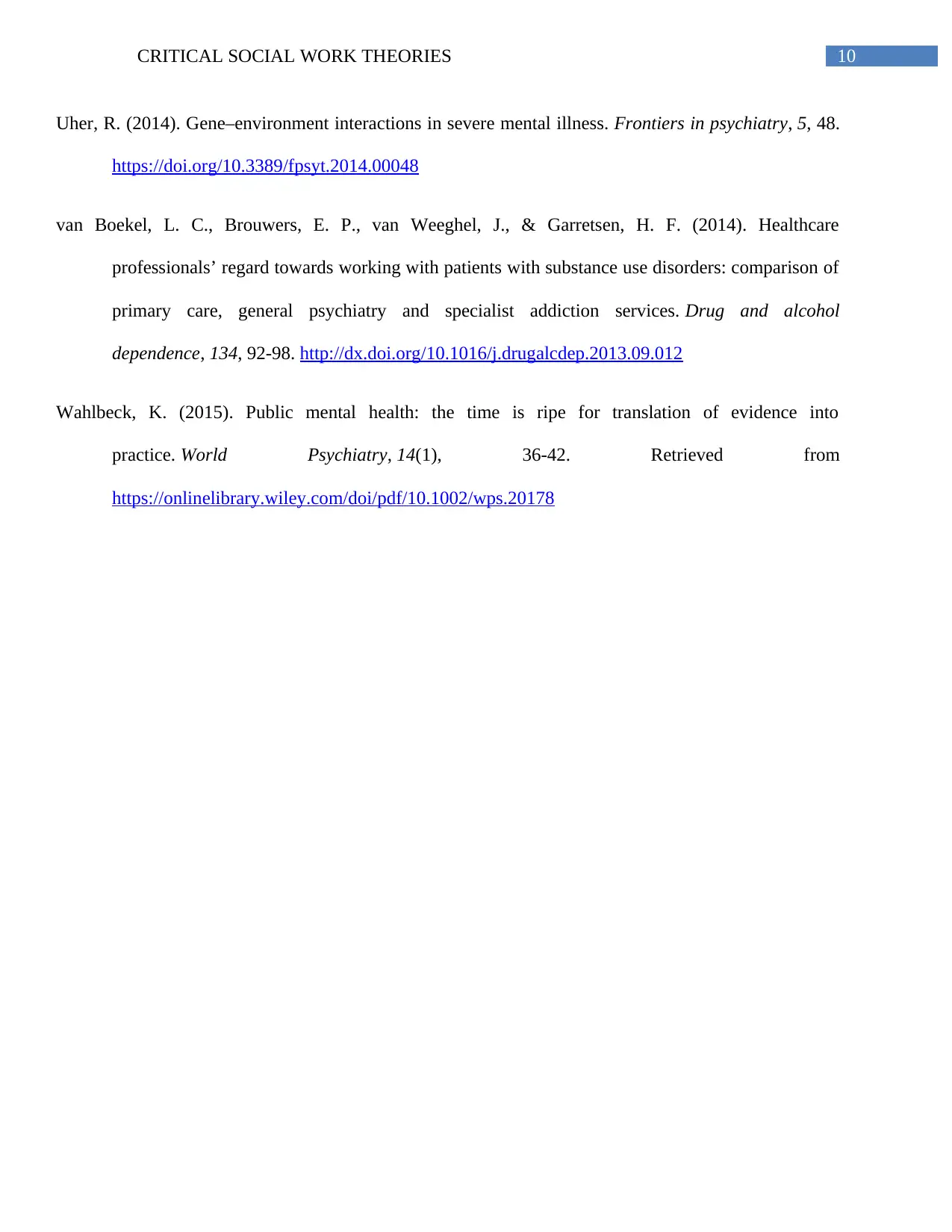
10CRITICAL SOCIAL WORK THEORIES
Uher, R. (2014). Gene–environment interactions in severe mental illness. Frontiers in psychiatry, 5, 48.
https://doi.org/10.3389/fpsyt.2014.00048
van Boekel, L. C., Brouwers, E. P., van Weeghel, J., & Garretsen, H. F. (2014). Healthcare
professionals’ regard towards working with patients with substance use disorders: comparison of
primary care, general psychiatry and specialist addiction services. Drug and alcohol
dependence, 134, 92-98. http://dx.doi.org/10.1016/j.drugalcdep.2013.09.012
Wahlbeck, K. (2015). Public mental health: the time is ripe for translation of evidence into
practice. World Psychiatry, 14(1), 36-42. Retrieved from
https://onlinelibrary.wiley.com/doi/pdf/10.1002/wps.20178
Uher, R. (2014). Gene–environment interactions in severe mental illness. Frontiers in psychiatry, 5, 48.
https://doi.org/10.3389/fpsyt.2014.00048
van Boekel, L. C., Brouwers, E. P., van Weeghel, J., & Garretsen, H. F. (2014). Healthcare
professionals’ regard towards working with patients with substance use disorders: comparison of
primary care, general psychiatry and specialist addiction services. Drug and alcohol
dependence, 134, 92-98. http://dx.doi.org/10.1016/j.drugalcdep.2013.09.012
Wahlbeck, K. (2015). Public mental health: the time is ripe for translation of evidence into
practice. World Psychiatry, 14(1), 36-42. Retrieved from
https://onlinelibrary.wiley.com/doi/pdf/10.1002/wps.20178
1 out of 11
Your All-in-One AI-Powered Toolkit for Academic Success.
+13062052269
info@desklib.com
Available 24*7 on WhatsApp / Email
![[object Object]](/_next/static/media/star-bottom.7253800d.svg)
Unlock your academic potential
Copyright © 2020–2025 A2Z Services. All Rights Reserved. Developed and managed by ZUCOL.

